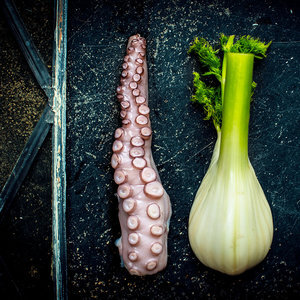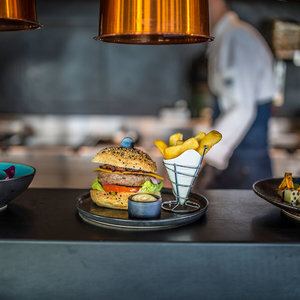A Taste Of Food Photography
It takes a lot of focus and precision to capture appetizing photos. The tricky part about food photography is that it can quickly become unappetizing. To achieve fresh and colorful food photos, several components need to be considered. At Supersky, we do a lot of food productions and have learned a great deal from food stylists we’ve worked with. It’s amazing how they can come up with magic tricks to make the dishes look colorful and almost unrealistically perfect to the eye. We’ll share some of these magix tricks and emphasize the importance of having the right photographer.
Hero ingredient
Before we dive into a dish, it’s crucial to identify the hero ingredient. This can really influence the vibe and theme of the photo. By theme we mean finding the right backgrounds that complement the dish and align with its appearance or, if it’s for a restaurant, match with the brand. Luxurious products such as lobster or truffles are stunning to capture and should receive the attention they deserve. Garnish is secondary and merely an instrument to further shape the plate. So don’t get distracted by garnish and focus on the hero of the plate.
Textures & themes
As described above, surfaces and textures are crucial. The use of different textures can make a composition exciting or interesting. Take our shoot for Liefdegesticht for example, where we used old elements from the building such as stained glass, tiles and doors. These surfaces enhance the theme surrounding the dish and add depth to the photos.
Light
Then, of course, there’s the basics of photography: light. The foundation of all photography is light and its intensity. In food phoography this plays an even more crucial role. Besides being instrumental in setting the mood, light serves another purpose here. When we’re tasked with photographing food, we rarely use artificial light or flashes. In our experience, food requires a gentle touch and therefore natural daylight is the most common way to illuminate a dish. A significant advantage of daylight is that it preserves the natural colors of ingredients, giving the dish a fresher and more flavorful appearance. We often use fast, long lenses to capture more daylight and to focus more on the hero ingredient of the dish. At Supersky we are big fans of a good daylight studio where the light can be directed and controlled from all angles. With summer approaching, creating blonde (overexposed) food photos with a rustic look is a breeze in these kinds of studios.
Colour & distribution
Colour is highly influential in whether a dish looks appetizing or not. A dish with little colour can quickly appear dull and unappetizing. A good example is a plate of Indonesian chicken skewers topped with satay sauce. Creamy and thick sauces with little colour are difficult to capture. What tastes good doesn’t always look appetizing. Therefore, it’s important to treat the plate like a canvas and cleverly distribute the ingredients, especially the sauces. For example, by placing satay sauce in a nice, small bowl and cooking the chicken skewers with a gas burner to achieve a beautiful, balanced well-done look, you can determine the composition yourself. With a gas burner you can also draw nice grill makrks on the meat. Using colourful spices on the meat adds more color and contrast ot the dish.
The Chef
Communication with the chef is also very important. As a photographer, it’s crucial to understand the chef’s vision for the photo. Sometimes achieving this vision may require some cheating, such as substituting ingredients to make them look better in the photo. This cheat may also involve spraying hairspray over a platter of Fruit de Mer costing 63 euros to give it a nice glossy effect. For some chefs, seeing their expensive high-quality products sprayed with hairspray can be quite unsettling. Therefore it’s important to sit down with the chef beforehand to avoid any disapproving glances from the kitchen while working with the dish.
TOOLS & TRICKS
Oil
A dish, especially meat, can quickly dry out, which becomes quite noticeable with today’s high-end resolution cameras. To keep the meat looking fresh and juicy, you can use a brush or plant mister to apply oil.
Paint & Varnish
Sometimes oil isn’t enough to enhance the appearance of, for example, chicken. You can use wood lacquer to glaze the meat, giving it the appearance of being marinated.
Fresh products
Always use fresh ingredients. Many ingredients tend to discolour quickly, and while this can be somewhat corrected in post-production, it’s more challenging with meat products.
Gelatin
Tapping a perfect beer is one thing, but capturing it perfectly can be an impossible task. The creamy layer of foam can quickly dissolve before you’re ready to capture it on camera. To keep the layer of foam thick and sturdy, we use gelatin. With this, you can essentially photograph all day with the perfect foamy layer.
Sweet spot
A aperture of 5.6 provides the best depth of field.
Hairspray
To achieve beautiful water droplets on a beer bottle or ice-cold glass of soda, we use hairspray. By spraying the bottle or glass with hairspray and allowing it to dry thoroughly, you’ll get a nice textured relief. This effect lasts all day.






